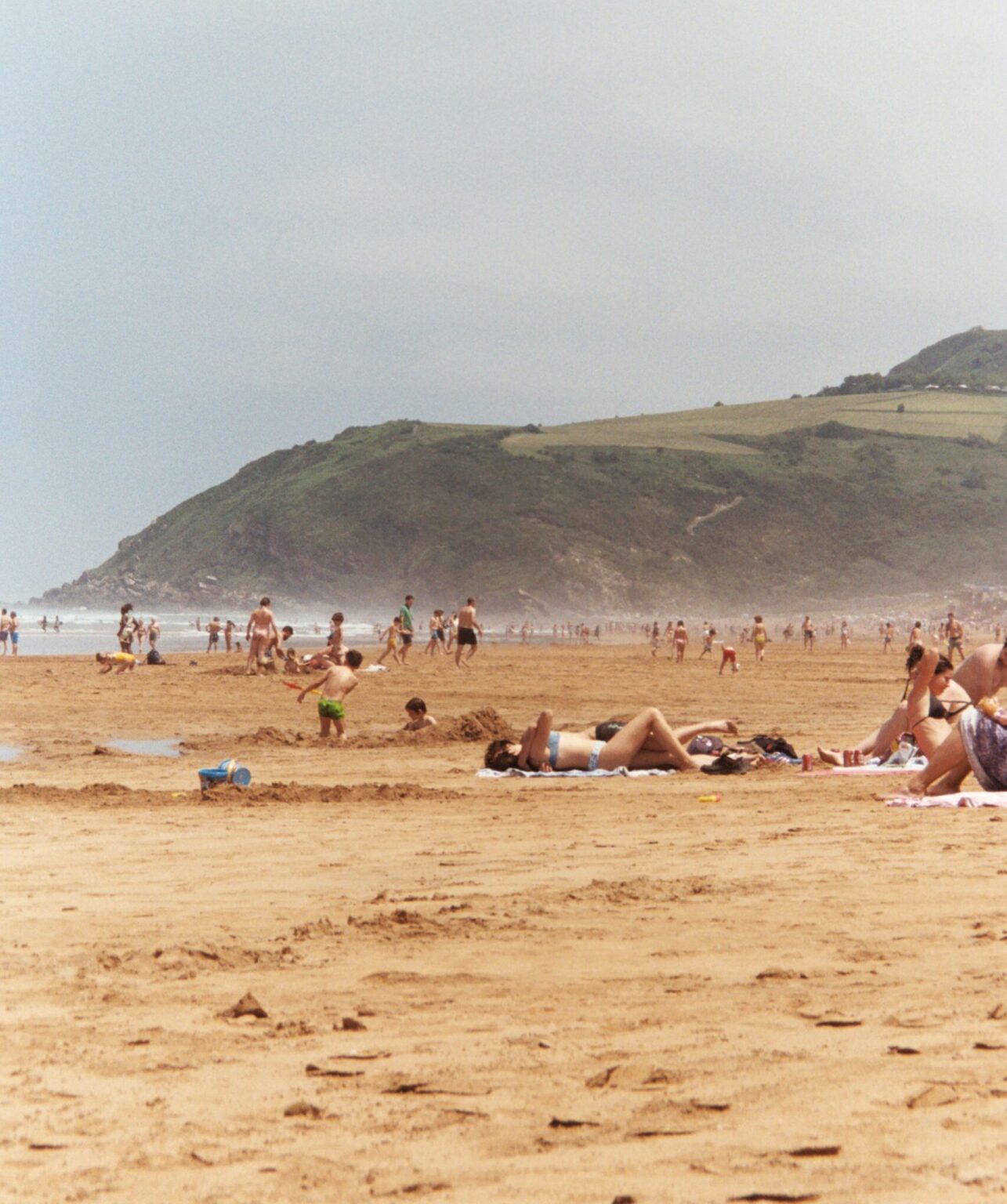When it comes to summers in the UK, there is perhaps none spoken of more often than 1976. The famous ‘long hot summer’.
Many that lived through it speak of relentless hot days, a seriously parched landscape, and severe restrictions on water usage.
To this day, it’s often referred to as a benchmark summer, the hottest on record… but is that true? This shall be delved into shortly, but first, let me set the wider scene.
Regional Heat
In Europe, by the standards of 1991-2020, the summer of 1976 was notably hot in the UK, Ireland, northern France, and Belgium. Meanwhile, it was considerably cool in south-eastern Spain and most of south-eastern Europe.
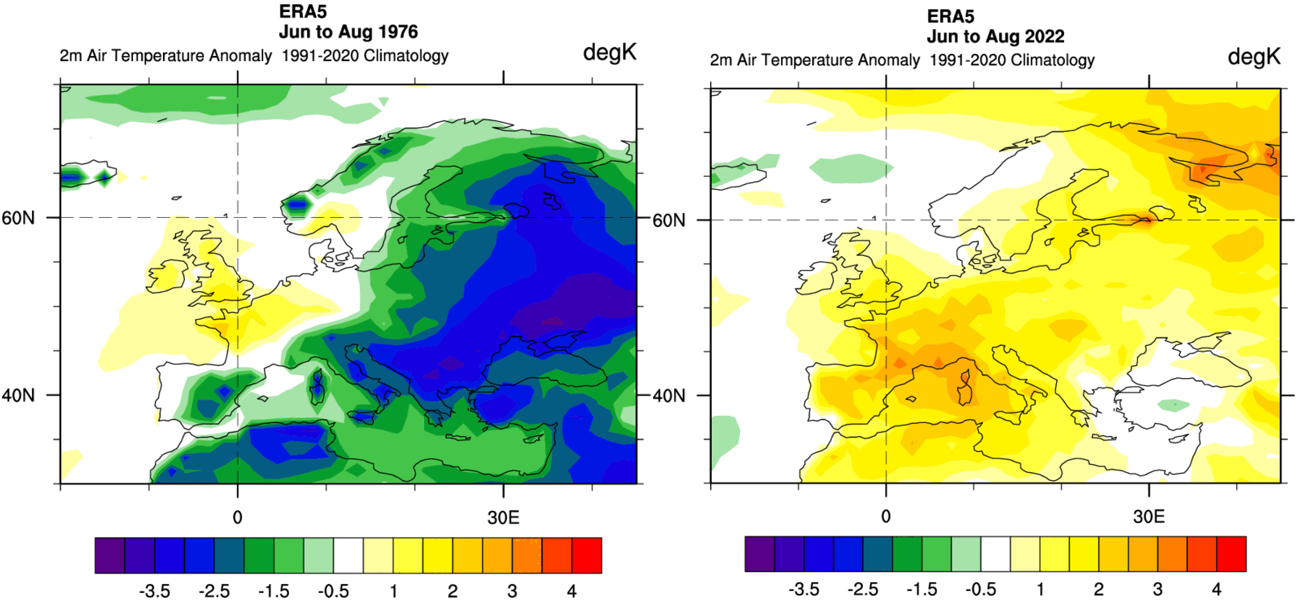
The impressive run of hot weather was a relatively small-scale event, the result of an exceptionally dry preceding winter and spring being followed by a very dry and sunny summer.
Recently, summer 2022 matched 1976 for the UK mean temperature. Comparing the two, you can see why 1976 provides no real argument against a long-term warming trend. In 2022 the UK was merely within the margins of an almost continent-wide hot summer. It also wasn’t as dry as 1976 during the preceding winter and spring, although a drought did affect some areas.
Now, let’s look at how persistent the hot weather of 1976 was in the UK & Ireland.
A Tale of Two Heatwaves
Among those who experienced that summer and ‘remember it well’, the fact that has placed the most surprised looks on faces is that the weather wasn’t hot for the opening two-thirds of June or mid-July through early August. This is plain to see in the graphs of UK-averaged daily maximum and minimum temperatures. During those two periods, the maximums are mostly in the 18-20°C range. That typically corresponds a range of mid-teens to mid-20s °C between the coolest and warmest areas of the nation.
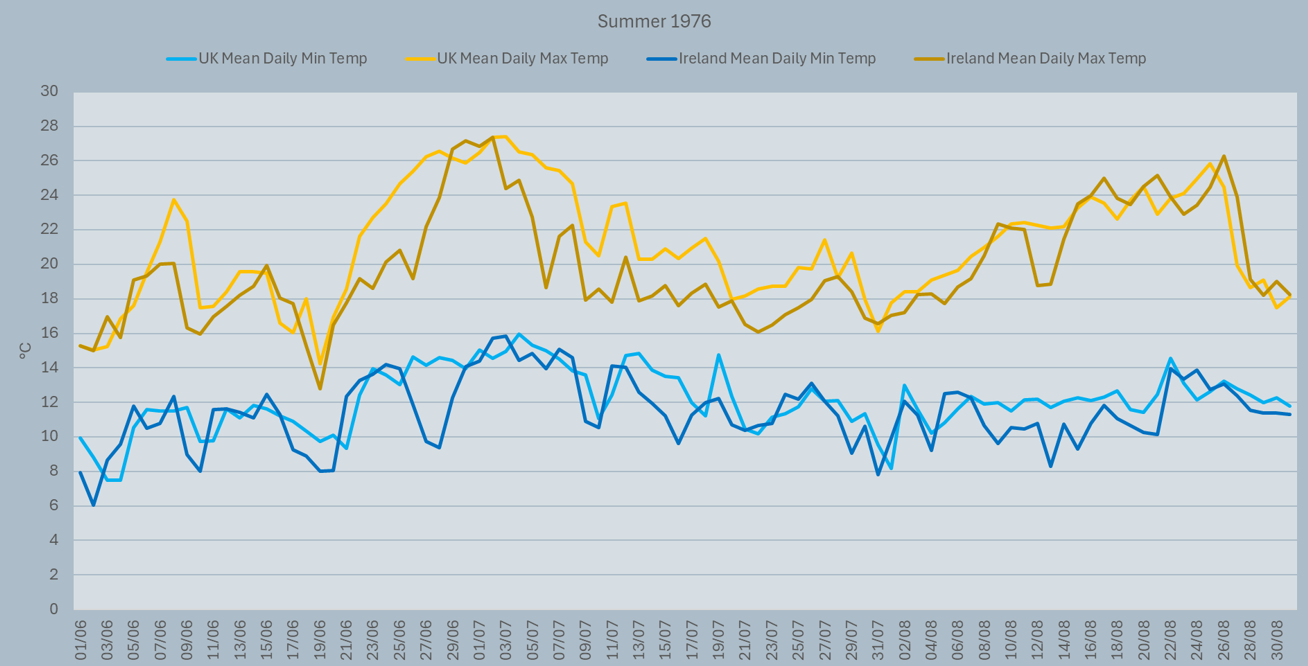
It’s the long, intense heatwaves in between that are seared into people’s memories. Our brains are naturally geared toward memorising situations that stand out from the norm, while unremarkable situations are usually discarded, such that the unusual ones can become ‘stitched together’ into a singular event.
The heatwave in the final third of June remains unrivalled to this day for its duration of very hot days in England and Wales. This is even more impressive when considering how early in the summer it was. UK temperatures usually peak sometime mid-July to mid-August.
The 2nd half of August heatwave also stands out, occurring after the seasonal peak. Overall, the timing of the hottest weather is a big part of what keeps 1976 so high in temperature rankings.
Speaking of which, how about we indulge in some summary maps for good measure?
Toasty Days
If we focus on the daytime highs, it was indeed an impressively hot summer in England, Wales, and much of Northern Ireland. Mean daily maximums were widely 1-2°C above the 1991-2020 average, locally over 4°C above. By this measure, it remains the record-hottest to this day for at least half of each country.
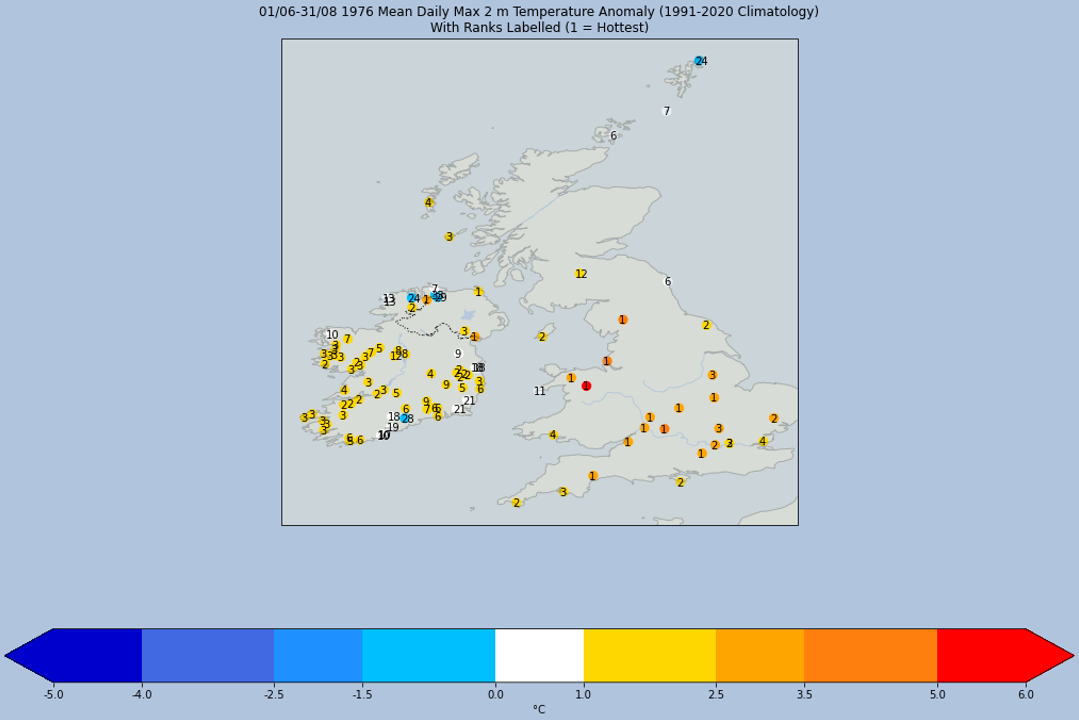
In Ireland and Scotland, it was also impressively hot by day but widely ranks 2nd-5th and in some spots outside the top ten. Yet Ireland’s longest heatwave is still held by 1976, spanning 14th-27th August at two locations: Birr Castle, Co Offaly, and Ballybrittas, Co Laois. That’s a full fortnight, extraordinary for a country at the mercy of the North Atlantic’s fitful character.
Relatively Cool Nights Inland
Looking at the mean daily minimum temperatures, we find a less consistent picture. The hot weather increased nearshore sea temperatures to much warmer than usual, which kept many coastal locations unusually warm overnight. However, further inland, the nights often dipped to near or below the 1991-2020 average.

This inland coolness was facilitated by the exceptional dryness of the landscape. Dry soils change temperature faster than wet soils, so they contributed to both higher daily maximums and lower daily minimums.
In Ireland, the eastern coasts saw a warming effect, but the western coasts didn’t. This is testament to the North Atlantic sea temperatures having been in a relatively cool state at the time.
The Net Result: 1976 is Nearly the Hottest UK Summer
Overall, the relatively cool nights inland make for mean temperatures mostly warmest to 4th warmest on record in England, Wales, and much of Northern Ireland. In Ireland it was widely 3rd-5th warmest inland but 4th-12th warmest near the coasts.
The record for hottest summer by UK-averaged temperature is now jointly held by 2006 and 2018, while all of 1976, 2003, and 2022 are tied for 2nd place (source).
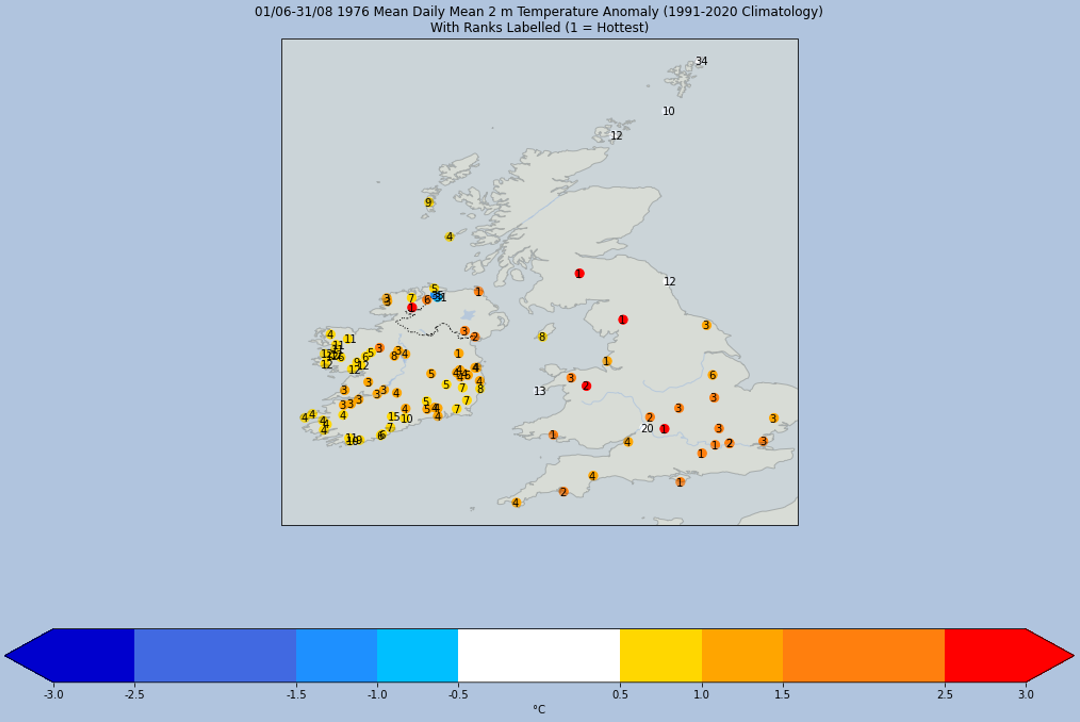
Hotter Summers Since
2006 has since taken the record for the UK’s highest summer mean daily maximum temperature. It achieved this largely by being hotter in Scotland. For England and Wales, 1976 still holds onto the record to this day (as of writing in July 2025).
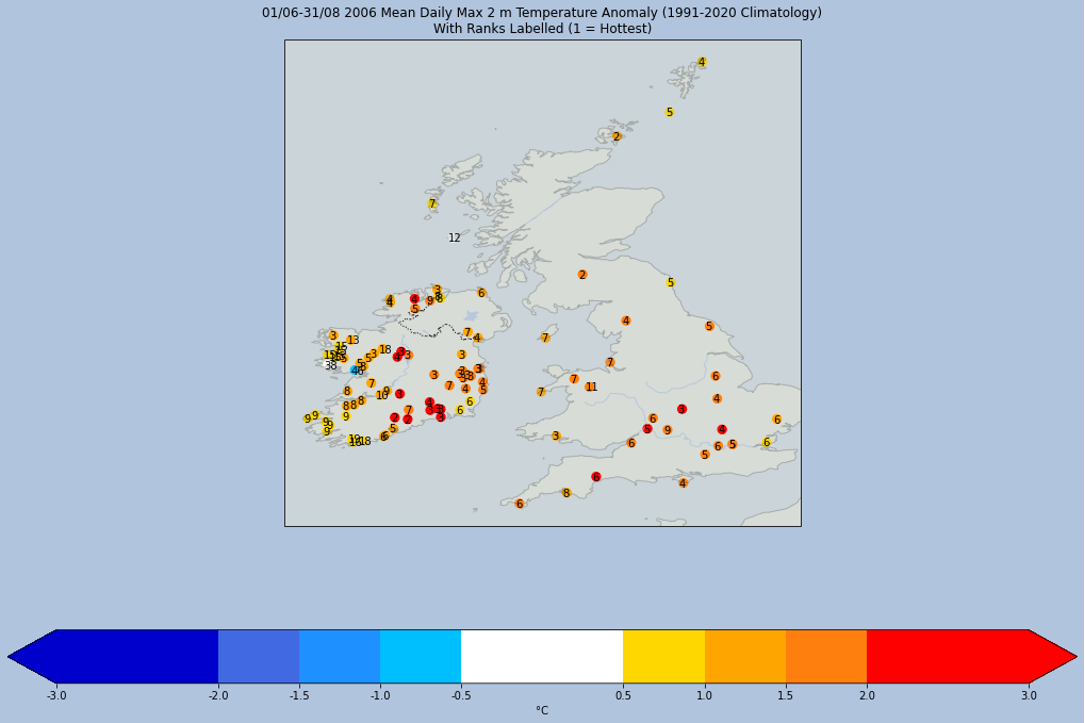
In England, summer 2018 was the hottest on record for the overall mean, warmer nights more than offsetting not quite so hot days when compared to 1976. In Ireland it was the 4th hottest, just below 2006. The hottest summer there occurred three decades ago, in 1995.

The record for England was then matched just four years later by summer 2022. Notably, it didn’t rely on long heatwaves to do so, instead shorter but more intense spells of hot weather, including the one that saw the first reliably recorded temperatures of over 40°C in the UK.
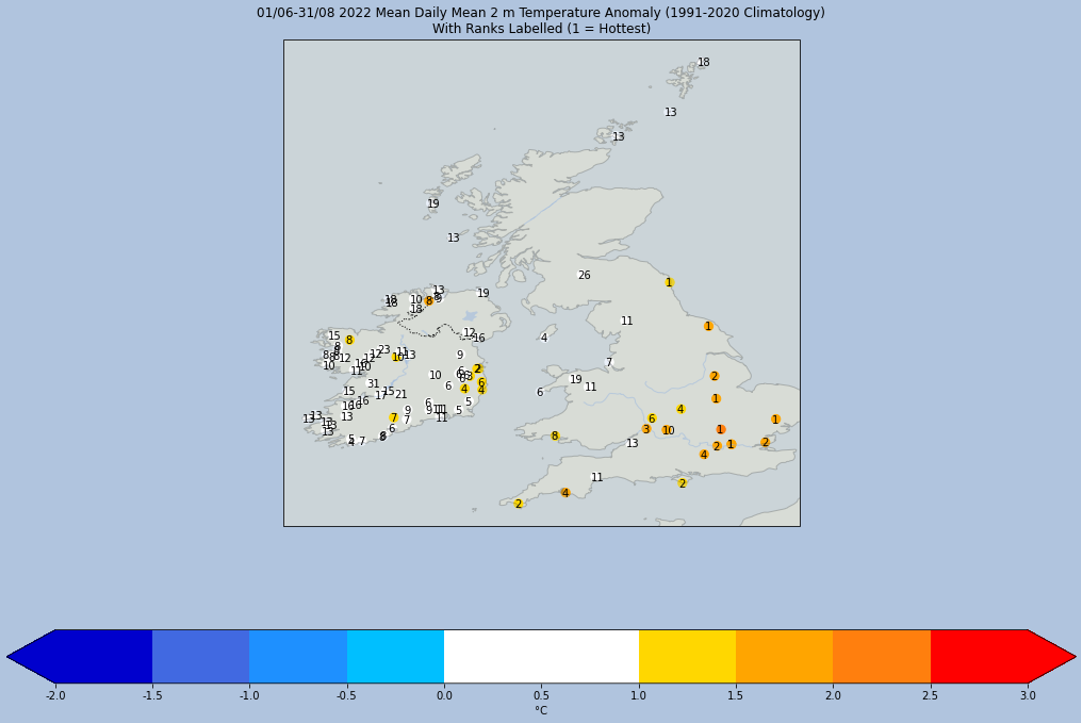
Notice how the distribution of the largest positive temperature anomalies and high rankings varies between the summers. Depending on where they live, people will have different perspectives on how 1976, 2018, and 2022 compare.
Finally for this section, let’s look at how the day-to-day UK and Ireland weekly mean daily maximum and minimum temperatures varied across these four summers.

In the UK, they were all relatively cool in the first half of June. This is a common feature of UK summers generally, due to the seas taking longer to warm up than the land. There’s usually a cooling maritime influence that gradually eases off during the month, unless a heatwave accelerates the process. Occasionally, a summer breaks the pattern entirely, such as 2023 which saw anomalously hot weather throughout most of June.
We can see that 2006 leaned heavily on an exceptionally hot July, while 2022 relied on a hot July and first half of August. 2018 was instead hottest June-July, with the heatwave in 2nd half June being about as close as we’ve seen to a repeat of 1976 for both timing and intensity.
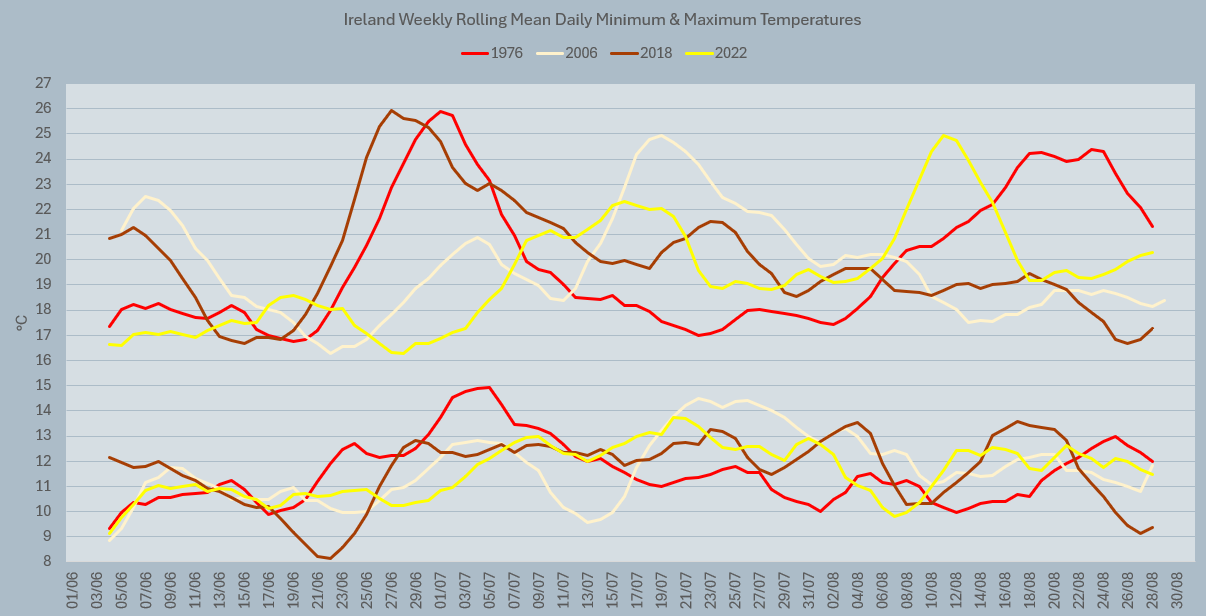
The overall patterns are similar for Ireland, the main difference being that the heatwaves are mainly shorter in duration. Notably, 2018’s June heatwave was on par with 1976’s there.
Is 2025 a Contender?
At the time of writing, 2025 has laid down the 2nd warmest June on record for the UK, just shy of 2023, and the warmest on record for England.
July has been more mixed, but temperatures have mostly been above average, and the opening day reached 35.8°C at Faversham, the highest official UK temperature since 19th July 2022. There was also a heatwave toward the middle of the month that lasted 3 days in parts of the north and 4-5 in the south. At the time of writing, the mean Hadley Central England Temperature for 1st-24th July is 8th warmest on record. This has kept 2025 in view of the hottest summers, but it will take a well above average August for it to rival the likes of 2018. The latest prediction from Claros, MetSwift’s long-range predictive model, suggests this is unlikely. It paints a mixed picture for the UK, with temperatures above average in the south, but below average in central parts, and near average elsewhere.
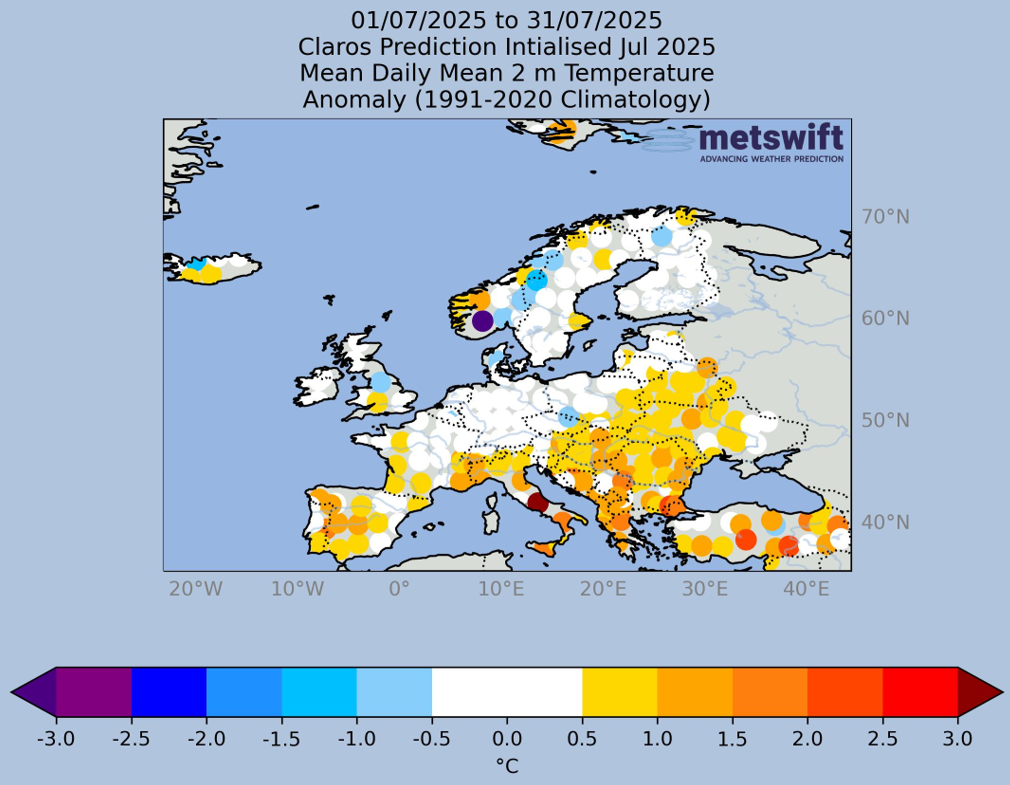
Outside MetSwift, seasonal forecast models are strongly in favour of a very warm August in the southern half of the UK, along with a large part of Europe.
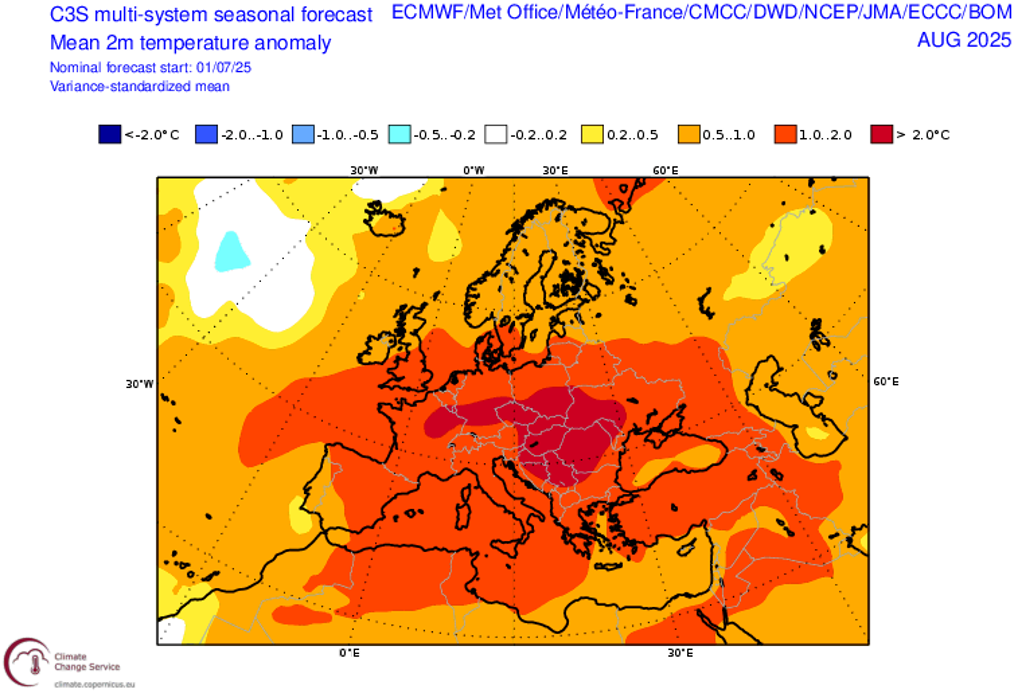
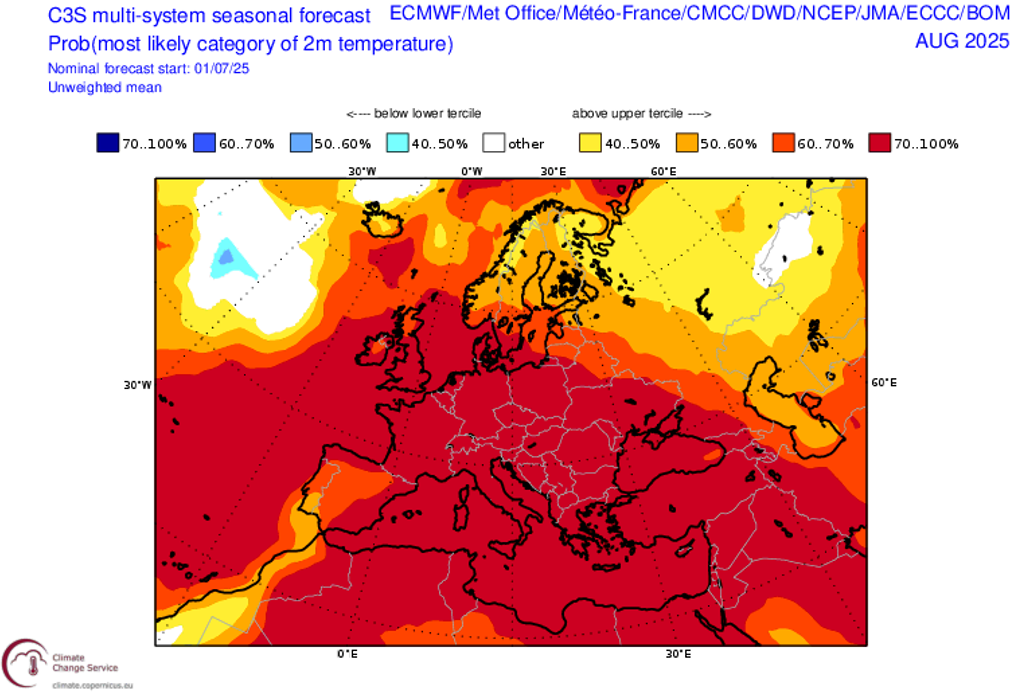
Shorter-term modelling currently suggests that August won’t start that way, with UK temperatures generally close to average. However, there are signs of a change to warmer than usual conditions during the second week of the month. In fact, some guidance hints at a return of hot weather, which I’ll be updating on via social media (@peacockreports).
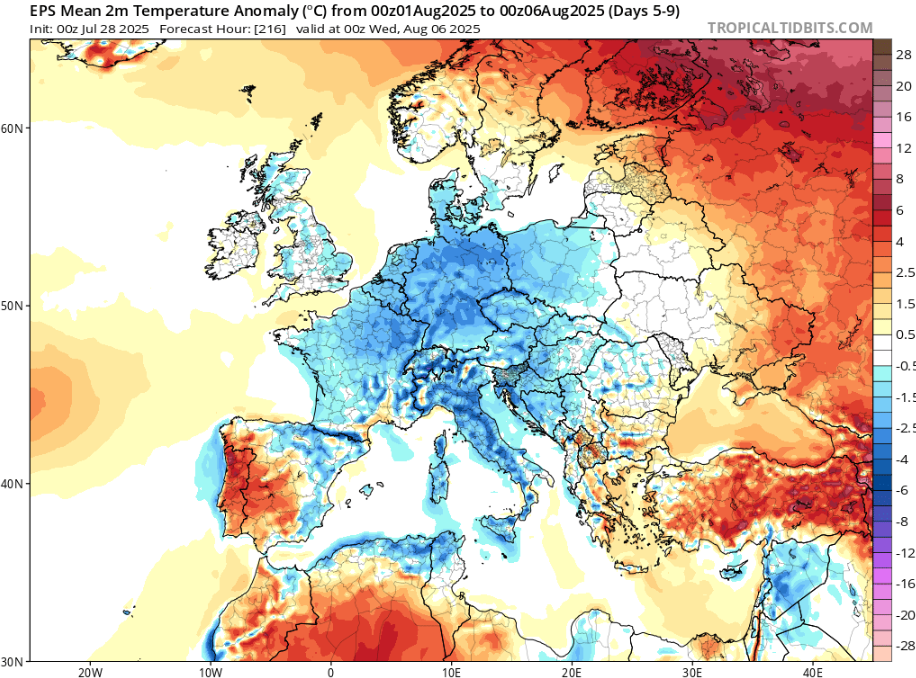
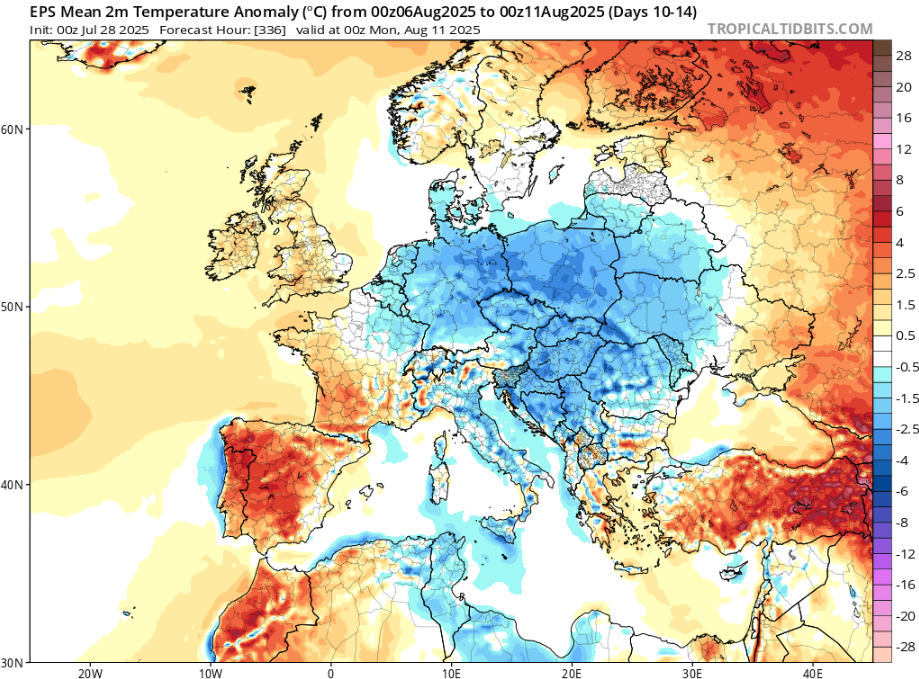
My overall impression is that August has a good shot at being anomalously warm in the UK & Ireland, but is unlikely to be among the hottest on record.
There’s not much sign of weather patterns conducive to long runs of hot weather, but with sea temperatures well above average around nearly all of Europe, the dice are loaded in favour of warm conditions. This has been evident in the second half of July, with some very cloudy, at times rainy days still managing to produce temperatures 1-2°C above average.
With all this in mind, you might think the chances of a record-hot summer are small, but not so. The June-July combination will be warm enough that August need ‘only’ be around 1 to 1.5°C above average for 2025 to challenge the likes of 2018. That’s not a tall order when bearing in mind that the hottest Augusts are over 2°C above average.
This is testament to the typically varied nature of the British – and even more so Irish – summer. As covered earlier, even 1976 had some markedly cooler episodes. This isn’t the Mediterranean, after all!
However the remainder pans out, I hope you can find plenty of enjoyment in the still-long days.
James Peacock MSc
Head Meteorologist at MetSwift
